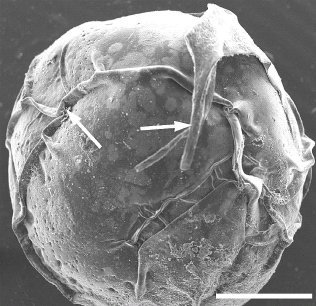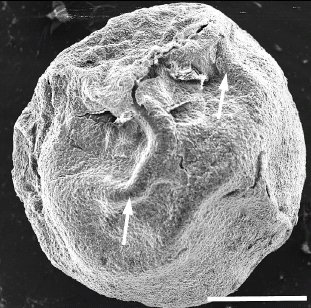The remnants of countless, unambiguous animals first appeared in the fossil record during the Cambrian Period, which began some 543 million years ago. However, molecular clock estimates based on how DNA has diverged from species to species put the explosion of diversity at up to about 1500 million years ago. This apparent discrepancy in early animal evolution has remained an enigma. Now, British researchers hope to offer a new explanation.
Scientists have attempted to explain the fossil enigma, the paucity of animals in the Precambrian fossil record, as being due to a lack of hard parts among these creatures and their likely small size and so their facile degradation. But, this is probably only part of the answer, fossilized eggs and embryos were recently discovered in Precambrian deposits, which may help to shed light on early animal evolution.

Fresh egg
John Parkes from the Department of Earth Sciences at Bristol University, Derek Martin – now at Cardiff University – and visiting professor Derek Briggs have shown how soft tissues, such as invertebrate eggs, can become coated in calcium carbonate, mineralized, at least under laboratory conditions, without a requirement for hard body parts to provide the fossil. Mineralization, the researchers have found, occurs very rapidly, taking less than three weeks in the absence of oxygen and at lowered pH. Critically, the process is mediated by bacteria. Conventional fossils form under a variety of circumstances and mostly over longer timescales.
According to the team, the findings reinforce the idea that the recently discovered fossils are indeed eggs and embryos of animals rather than algal cells, as had previously been suggested. This experimental approach will provide a basis for more extensive investigations of the processes and conditions that lead to the mineralization of embryonic material, say the researchers, and, subsequently, should help us assess the significance of fossil material for analyzing the early evolution of animals.

Mineralized egg
This is the first observation of laboratory mineralization of such eggs in the absence of a decaying carcass. It demonstrates that eggs, and perhaps small embryos, could be preserved even if no larger organism were present to act as a phosphorus or calcium source. Thus, say the researchers it is possible for organisms of this size to have been fossilized prior to the evolution of the large organisms during the Cambrian period, the metazoans.

Derek Martin
Professor Briggs is co-author of The Fossils of the Burgess Shale.

John Parkes

Derek Briggs
Further reading
Geology, 2003, vol 31(1), 39-42
http://earth.geology.yale.edu/people/moreinfo.cgi?netid=deb47
The Fossils of the Burgess Shale (Amazon link)
http://www.amazon.co.uk/exec/obidos/ASIN/156098659X/davidbradleyse0e
Suggested searches
fossils